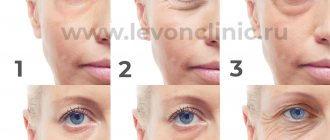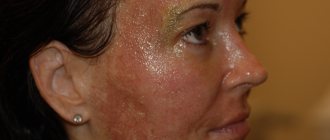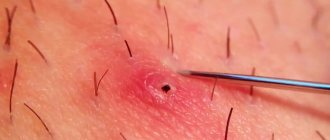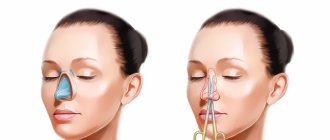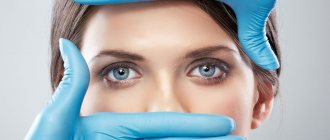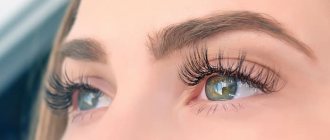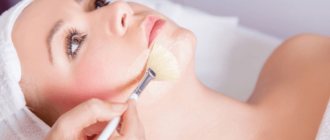This article was prepared by our beloved partners - the #GMfood - an online store of superfoods and craft eco-products.
Just for registering in the store you will receive 300 rubles to your personal bonus account and 2 more interesting gifts (Grab your gifts here)In the store's assortment you will find not only superfoods, but also healthy sweets, breakfasts, herbal teas, peanut butter, master classes for body health and facial beauty, and this is only a small part of the goodies and benefits!
Subscribe to Instagram #GMfood using this link and regularly receive new PP recipes with superfoods, see useful guides to the world of proper nutrition, and also look for gifts hidden under the link in the profile!
How you want to look like a movie star with a beautiful complexion and perfectly smooth skin, without puffiness and bags under the eyes. It is especially impossible to look at yourself in the morning after a long party. You open your eyes, and a difficult-to-recognize appearance looks at you, and you have to go to work or study. Sound familiar? How to remove swelling from your face so that you look, at a minimum, passable, and ideally, like a fashion model in a beautiful photo.
- Is it possible to achieve real results at home?
- Why does the face swell even in young women and young girls? What does this mean?
- How to hide puffiness after a late party, a heavy meal and alcohol?
- Why does swelling contribute to sagging skin and premature aging?
- How to quickly remove swelling after surgery, overwork, or excessive stress?
- Is it possible to restore freshness and perfect smoothness to the skin forever?
The answer to many of the questions asked is: – Yes!
However, everything is in order.
Causes of swelling on the face
Facial swelling is not a disease, but only a symptom of various pathological conditions or functional disorders that are accompanied by excessive accumulation of fluid in cavities and tissues: • kidney diseases - glomerulonephritis, nephrotic syndrome, renal failure; • cardiac dysfunction – heart failure; • damage to veins (varicose veins, inflammation, thrombosis); • liver diseases – cirrhosis, blockage of the hepatic veins; • diseases of the endocrine system: hypothyroidism, diabetes; • severe oncological diseases; • nutritional dystrophy; • allergic reactions – insect bites, contact with allergens.
However, many believe that this unpleasant symptom can be eliminated by simply reducing the amount of fluid consumed. Indeed, sometimes swelling on the face occurs due to drinking too much, but often the swelling is precisely the result of a lack of water. It is dehydration that can lead to metabolic disorders. Dehydration will cause the body to begin to react to any liquid: even 2 cups of tea will cause swelling of the face.
Another important point is the quality of the liquid consumed. It is necessary that the basis of drinking is ordinary clean water. If you drink only tea, coffee, and sweet soda during the day, swelling is inevitable. Such drinks contain substances that promote fluid retention rather than removal. This inevitably leads to impaired outflow and swelling of the face.
Impaired water balance is the main cause of swelling in healthy people, but it is far from the only one. Facial swelling may also occur due to the following factors: • Diet . Certain foods retain fluid in the body. We are talking mainly about salt - excessive sodium consumption leads to swelling of the face and limbs. Spicy and fatty foods, simple carbohydrates (sweets), and fried foods also have a detrimental effect on water balance. • Diet. A person may skip breakfast, eat only fast food during the day, or overeat heavily at night. This regimen inevitably causes swelling on the face, which appears closer to the morning. • Excess weight . Excess body weight has a detrimental effect on the body as a whole, and if the face often swells against the background of excess weight, this may indicate a malfunction of the cardiovascular system. • Overwork . Lack of sleep often leads to swelling. As a rule, the face in such cases swells in the morning. • Pregnancy. During the period of gestation, the female body undergoes restructuring, metabolism changes, and kidney problems are often observed.
This causes swelling not only of the face, but also of other parts of the body. Swelling that occurs under the influence of the above factors completely disappears on its own within 1-2 hours. It is also irregular and can appear with different intensity on different days. If swelling is observed daily, does not go away well (for example, only after taking diuretics) and is accompanied by other symptoms, you need to undergo a medical examination.
Home Remedies
If negative manifestations on the face are not associated with diseases, then time-tested folk recipes will help eliminate the problem. Let's look at some of them.
Contrast wash
The face is doused with water, the temperature of which changes every 15 seconds to cold, then hot. Improvement occurs due to the activation of blood circulation after disturbances that caused pastosity.
Contrast compress
You will need to brew 1 tablespoon of dried medicinal herbs in 200 ml of boiling water: calendula, chamomile, lingonberry, St. John's wort. When the broth has cooled, another hot portion is prepared in the same way.
A piece of gauze is immersed in the hot infusion and applied to problem areas for 1 minute. After this, the gauze is immersed in the cooled mixture and applied for 1.5 minutes.
This method helps to quickly eliminate morning swelling resulting from a hectic night.
Self-massage (3 stages)
Self-massage also brings great benefits. The main thing is that it is easy to do at home.
As soon as you begin to notice the appearance of swelling, you should lie down, and then, in a relaxed state, carry out a long facial massage. To do this you need:
- Lightly tap the skin surface with your fingers, following the massage lines.
- Pat, but not too much, on the forehead, cheeks, and chin.
- Pinch the skin.
Experts advise doing massage regularly, every morning. This is an excellent prevention of edema.
Diuretic tea
To prepare, you need to brew 2/3 cups of green tea and dilute it with 1/3 milk. This remedy is characterized by a strong diuretic effect, eliminates pastiness of the legs and face in kidney diseases.
Ice
Frozen decoctions made from birch, plantain or chamomile buds are good for swelling.
Green tea or water also copes well with the problem. You need to wipe your face with pieces of ice in the morning.
Potato mask
The raw vegetable is crushed to form thin circles, and a kind of compress is made on the face.
There is a second application option. The root vegetable is boiled, kneaded and placed hot on the swelling; you can additionally add chopped parsley or dill to the mask.
Folk remedies are not able to eliminate severe or old swelling, but minor disorders can be dealt with quite quickly.
Masks with dill or parsley
To eliminate swelling, you should use the usual greens. For example, dill can come to the rescue. It is crushed and mixed with sour cream in a ratio of 1:2. The prepared mixture is applied to the face.
Parsley also benefits. It is also crushed, and the resulting pulp is added to the potato mask, which was described above.
Quick help of cucumber or soda
If you need to quickly reduce swelling, then look in your refrigerator for a regular fresh cucumber. Wash it. Next, apply pieces of this vegetable to your face for a quarter of an hour.
It is recommended to do a cucumber mask daily.
Baking soda can also help. Initially, take half a mug of water, previously boiled and cooled. A quarter teaspoon of soda is added to it.
Cotton pads are immersed in this liquid and applied to the area of the face where swelling has occurred. They are removed after 10-15 minutes.
Using pumpkin, apples or cabbage
Pumpkin can help cope with swelling. To do this, you will need its pulp (about 100 grams), which is filled with water (half a glass). This mixture should stand on the fire until softened.
When it all cools down a little, add a teaspoon of honey. After this, gauze is applied to the skin of the face, on which the prepared composition is spread. Cover it all with a plastic bag. The mask should remain on the face for a third of an hour.
Grated apple effectively helps to quickly remove swelling. It is applied to the face and kept for a quarter of an hour.
If you have cabbage on hand, you can use it. You will need a cabbage leaf, which is first immersed in boiling water to soften it.
It is sprinkled with lemon juice and spread with honey. All this is applied to the problem area for half an hour.
Types of swelling
Doctors at the Quality of Life clinic treat edema of various origins: • Heart disease. In such cases, the face swells slowly over several weeks or even months. The swelling is often symmetrical and increases in the evening. As a rule, in the initial stages they occur on the legs, in severe cases they spread to the abdominal area and face. The skin is often very cold and the swelling is dense. With such edema, shortness of breath is observed, which intensifies in a horizontal position, and low tolerance to physical activity. Sometimes tachycardia is observed, lips turn pale. As the deficiency is compensated, swelling decreases or disappears. • For venous insufficiency. As a rule, such facial swelling is also characterized by manifestation in the evening, they are accompanied by a feeling of heaviness and fatigue. First, the legs swell, then the face; in severe cases, trophic changes appear on the skin - thinning, itching, redness, peeling. • For kidney diseases. They can develop very quickly - in less than a day. Swelling appears mainly around the eyes, and is especially noticeable in the morning after waking up. Less commonly, they are localized on the legs and abdominal wall. When changing position, the body quickly shifts. Often there is an accumulation of fluid - ascites or hydrothorax. Edema skin becomes soft or tight, pale and dry. With kidney pathologies, the amount of urine excreted may decrease, its color, composition and consistency may change. Sometimes blood and protein may appear in the urine. It starts to hurt in the lumbar region. Nonspecific manifestations include headaches and weakness. Shortness of breath and liver enlargement are often not observed. Renal edema can be caused by past infectious diseases (tonsillitis, viral infections), and patients with such disorders should be observed and treated by specialized specialists - rheumatologists, nephrologists. • Edema of allergic origin . They develop very quickly (in just a few minutes) and are regional in nature. Such disorders arise as a result of contact with allergens and are localized on different parts of the face - eyes, eyelids, mucous membranes, lips. Sometimes they can appear on the arms, elbows and knees. With allergic edema, itching and various rashes are possible. In severe cases, bronchospasm can make breathing difficult (often on exhalation). Swelling of the larynx can cause suffocation and threaten life, so patients prone to such reactions need to be prepared for dangerous situations. It is important to discuss in advance with your doctor a list of medications that will allow you to safely wait for an ambulance and always have them on hand.
In addition, the face may swell due to diseases of the ENT organs. Swelling is provoked by inflammatory processes in the nasopharynx, throat and maxillary sinuses. In such cases, there is a general deterioration in the condition, headaches, fever, runny nose or cough. The symptom may go away only after the source of infection is eliminated. If the disease is chronic, manifestations of swelling of the facial skin are possible only during periods of exacerbation.
Often the face swells due to dental diseases. This can be caused by caries, inflammatory processes in the oral cavity, cysts and other disorders. In such cases, not the entire face swells, but only one area - in the jaw area. Without dental intervention, the swelling will not go away, but will only grow.
Another reason is endocrine diseases. With a lack of thyroid hormones (hypothyroidism), characteristic swelling occurs, localized in the upper part of the face, on the shoulders or lower extremities. The tongue may also swell and the neck may become significantly enlarged. Such symptoms require urgent consultation with an endocrinologist, since hypothyroidism can cause irreparable harm to health.
The localization of edema allows us to talk about the reasons for its occurrence:
•The accumulation of fluid in the frontal region may indicate osteomyelitis (Pott's tumor) with periosteal abscess (rare).
•Swollen eyelids often indicate the presence of eye diseases - conjunctivitis, stye, chalazion, inflammation of the lacrimal sac, as well as orbital complications of sinusitis. The latter include periosteal abscesses, orbital soft tissue inflammation and orbital abscess.
•Swelling of the cheeks. Localization of fluid accumulation in this area may indicate odontogenic infiltrate/abscess of the cheek, erysipelas or osteomyelitis of the jaw (very rarely) as a complication of maxillary sinusitis.
•Swelling of the parotid gland. Often, the accumulation of fluid in this part of the face indicates the presence of general inflammation of the salivary glands, recurrent mumps, acute bacterial parotitis or parotid lymphadenitis caused by atypical mycobacteria.
•The base of the nose and upper lip most often swells due to bruises. • Swelling of the submandibular area in newborns may indicate inflammation of the connective tissue • Tumors in the chin area - Ludwig's syndrome.
The face may also swell as a result of inflammation and deep skin infections that occur as a complication of folliculitis, inflammation of the sweat or sebaceous glands.
In such cases, local antibacterial therapy is required, since due to the anatomical connection of this area with the blood vessels of the brain, inflammatory processes can provoke a life-threatening condition.
Ice cubes
There is another express method - perhaps the main one in the arsenal of our mothers and grandmothers. These are ice cubes. Admit it, is it customary in your family to keep this SOS remedy in the refrigerator just in case of a sleepy face?
If yes, then now use ice only for cocktails, or apply it to the damaged area in case of injury.
Ice is a deceptive helper for the face.
It may only seem at first that ice cubes have an effect. Immediately after the procedure, the skin may look fresher, swelling will disappear, pores will narrow, and color will improve.
But, if you use ice in the system, the condition of the skin will deteriorate and it will begin to age faster. Moreover, the insidiousness of this method is that you will not correlate the progressive negative changes with your addiction to ice procedures.
Why is everything like this?
Because low temperatures are stressful for us, warm-blooded and heat-loving creatures. Due to constant “freezing”, blood vessels narrow, blood flow and lymph outflow worsen, muscles tense and spasm, collagen production in the skin decreases, and the secretion of the sebaceous glands decreases.
As a result, an anti-effect occurs. Swelling increases, pores expand, spider veins form, the skin becomes flabby, wrinkled and dry.
Lymphedema of the facial skin
Lymphoedema (lymphostasis) is a pathological condition of the lymphatic system, accompanied by difficulty or disruption of lymph outflow. As a result, lymphatic fluid begins to linger in the tissues. Most often, the disorder is observed in women aged 30-40 years. Despite the fact that the most common form of lymphostasis is lymphostasis of the legs, if the outflow of lymph is impaired, the face can also swell.
There are 3 stages of development of the disorder: 1. The swelling is barely noticeable and can arise or resolve spontaneously. 2. The swelling becomes irreversible as connective tissue begins to grow. This is accompanied by painful sensations. 3. Stage of irreversible changes. The face loses its outline and body weight increases.
Lymphedema can occur with varicose veins and venous insufficiency, benign and malignant tumors of the lymphatic system, after operations to remove lymph nodes, against the background of obesity, kidney or heart failure. Symptoms of lymphedema: • swelling of the limbs and face (swelling systematically appears and disappears, over time the duration of the edematous stage increases); • at the site of swelling, the skin thickens and tightens; • finger pressure on the affected area leaves marks that do not disappear for a long time; • the face loses its shape.
Treatment for lymphedema includes conservative and surgical methods. Surgical intervention is indicated in case of lack of effectiveness of conservative therapy - drug treatment based on the use of phlebotonics, immunostimulants, angioprotectors, lymphatic drainage massage and compression therapy. Your doctor may prescribe physical therapy, exercise therapy, and swimming to help relieve swelling in your face.
Patients with diseases of the lymphatic system need to understand that prevention of disorders is the most important task for them throughout their lives. Preventative measures include gymnastics and special exercises, strict limitation of salt and foods containing sodium, exclusion of tobacco and alcohol, and frequent walking.
Treatment regimen
Methods for dealing with excess fluid in tissues depend on the reasons for their accumulation.
The general treatment regimen includes changing the patient’s usual lifestyle:
- increased physical activity - daily exercise will help speed up metabolism, normalize the outflow of lymph and fluid from problem areas;
- revision of the work and rest schedule - adequate sleep allows you to regulate metabolic processes;
- refusal of alcoholic and low-alcohol drinks, especially in the evening;
- drinking enough clean drinking water - at least 1.5 liters per day.
Drug treatment is prescribed by a cardiologist or therapist and depends on the sources of swelling.
Disorders associated with swelling of the eyelids
Swelling around the eyes is a common problem that not only causes discomfort, but can also indicate serious problems. They represent the accumulation of excessive amounts of fluid in an area of loose connective tissue. As a result, significant swelling forms around the eyes.
Initially, the area around the eyelids is prone to swelling. This is due to the peculiarities of the structure of the subcutaneous fat layer. In addition, this area of the face contains many blood vessels. Swelling around the eyes is an alarming sign that there is a malfunction of the internal organs in the body. Aesthetics are very important, but many people forget about the importance of health before facial beauty. A cosmetologist will only relieve the external manifestations of pathology, which over time can lead to serious internal complications.
However, not in all cases swelling indicates a disease. Excessive consumption of liquids or salty foods can also cause swelling, but they go away on their own within a day and do not require medical intervention. You should contact a specialist if the violation has become systematic.
Swelling around the eyes is divided into the following types: • Inflammatory . They occur as a result of bacterial infection of the eyes. A pathogenic attack leads to the accumulation of pus and swelling of the eyelids. Visually, this disorder looks like redness of the moving folds around the eyes and compaction at the site of the inflammatory process.
• Allergic . With such swelling, external irritants enter directly into the mucous membranes of the eyes or along with food. The most aggressive form of the pathology is Quincke's edema - the face, back of the hands, neck and feet become very swollen. The disorder is often combined with food allergies, bronchial asthma, and urticaria. • Traumatic . They occur as a result of damage to the eyes, nerve tissue and facial muscles. With such swelling, the eyelid becomes more voluminous. • Reactive . They arise due to an inflammatory reaction in the paranasal sinuses.
Thus, swelling around one or both eyes may be caused by an infection or eyelid disease. The most common of these are stye, conjunctivitis, blepharitis, tear duct infection, keratitis and dry eye syndrome. So, with barley, the ciliary bulb becomes inflamed, and an abscess forms in the area of the affected eyelid. Conjunctivitis is accompanied by inflammation of the mucous membrane of the eye, and blepharitis is accompanied by inflammation of the ciliary edges of the eyelids. With these disorders, burning, itching, swelling and redness are observed. With dry eye syndrome, the production of natural tears decreases or completely stops.
Massage
A massage to relieve facial skin pastiness is carried out exclusively with your fingertips along massage lines in the morning. You need to do it starting from the cheeks. The direction of movement is from the cheekbones to the lower jaw.
The forehead massage is carried out from the bridge of the nose towards the temples along the superciliary arches. The area around the eyes is treated carefully along the skin over the bones from the inner to the outer edge of the eye. After this, the cheekbones are massaged from the wings of the nose to the ears.
Massage has a tonic effect on the tissues and vessels of the face and increases the outflow of fluid from the tissues, which helps to get rid of skin pastiness in the shortest possible time.
Other reasons
In addition to these reasons, swelling in the facial area may indicate diseases of the internal organs: • Impaired liver function. The circulation of fluid is disrupted, which accumulates in the abdominal area, and the abdomen enlarges. Gradually, swelling forms in the facial area. • Intervertebral hernia of the cervical spine. At the initial stage of this disorder, swelling begins in the lower eyelids (the result of a violation of venous outflow). Then stiffness of head movements develops and severe pain occurs. • Pathologies of the respiratory organs. Inflammatory processes in the lungs and nasal cavity cause swelling of one eye, which is closest to the source of inflammation. • Pituitary gland disorders, which are accompanied by hormonal imbalance. This leads to the accumulation of excess fluid in the body and the formation of swelling in the facial area. They often appear in the morning and subside in the evening.
If swelling occurs, especially if it is chronic, you should immediately consult a doctor. To establish the true cause of the violation, laboratory, instrumental and functional studies will be ordered.
Symptoms of pastiness
The word “pasty” comes from the English “dough”. It is with this that the texture of the skin of a person suffering from this disease is compared. This is due to the fact that when the face becomes pasty, the body’s water balance is disrupted. For this reason, there is a failure in the outflow of fluid through the lymphatic and venous network of the body, and the skin takes on an unattractive appearance.
Symptoms of skin pastiness are:
- swelling of the cheeks and neck;
- swelling of the eyelids;
- skin rashes;
- change in skin color;
- looseness of the skin and changes in its color;
- “jowls” - sagging cheeks;
- double chin;
- “bags” under the eyes;
- visual aging of the skin.
The places in which skin pastiness appears directly depends on the characteristics of the human body, his age and the presence of diseases.
How to get rid of swelling
To get rid of swelling, it is necessary to eliminate not only the accumulation of fluid itself, but also to cure the underlying disease - the root cause. Traditional medicine offers drug or surgical treatment, but in some cases it is possible to get rid of the problem without drugs or surgery.
This is where osteopathy comes to the rescue - a system of diagnosing and treating diseases, which is based on the idea that the connections between the functioning of organs and the musculoskeletal structure are crucial. Osteopathic correction is aimed at healing the body, and not at a specific problem. The swelling goes away when the bones of the skull, vertebrae and joints take their anatomically correct position. As a result, internal organs work harmoniously, the immune system is strengthened, the functioning of the genitourinary system and hormones is normalized, and the face stops swelling.
Osteopathic treatment at the Quality of Life clinic improves metabolism and digestion, affecting all systems and organs. It effectively eliminates all negative manifestations of diseases, including swelling, disruption of the gastrointestinal tract and musculoskeletal system. Osteocorrection has no contraindications and can be performed even on pregnant women and infants. Working with soft tissues normalizes blood circulation and lymph flow, eliminates pathological processes.
In addition to osteopathy, our clinic uses the following treatment methods: • Lymphatic drainage massage. It is aimed at improving lymph outflow, accelerating metabolic processes and stabilizing the functioning of the central nervous system. • Physiotherapy. It allows you to restore the functionality of organs and systems, normalizes the functioning of surrounding tissues, strengthens the muscular system, relieves or completely eliminates pain. Classes are strictly supervised by a doctor and take place in specially equipped rooms of the clinic. • Manual therapy. Its action is aimed primarily at the spine, intervertebral discs and bones. It affects the entire body as a whole, inhibits or stops the development of diseases. • Kinesiotherapy – movement treatment. Complexes of static, dynamic and functional exercises help to correct pathological individual movement patterns and form correct ones. They create optimal conditions for recovery and rehabilitation.
The combination of different methods helps restore and eliminate swelling by improving blood circulation and lymph flow. During osteopathic treatment, the doctor’s sensitive hands gently and painlessly “listen” to the tissues, checking the elasticity and mobility of the joints. Since everything in the body is connected, problems in the functioning of organs and tissues lead not only to fluid accumulations, but also to changes in the musculoskeletal structure. Manual muscle testing tests muscle response during movement. This allows the specialist to direct treatment in the right direction. A timely visit to the doctor is the key to a speedy recovery. Therefore, if your face begins to swell systematically, immediately visit a doctor.
Similar articles:
- Directions
- Specialists
- For visitors
- Articles and videos
“Healthy Summer” 1000 rubles discount on an appointment with osteopathic doctor E.A. Ukhmylin.
Adult admission 6 thousand, children admission 5 thousand.
Diagnostics and tests
At the initial appointment, the therapist listens to the patient’s complaints, conducts a physical examination and palpation, and collects an anamnesis of the disease.
A diagnostic examination for swelling of the legs will help to find out the causes and select treatment for women and men:
- general and biochemical blood test - detects gout and atherosclerotic damage to blood vessels;
- blood sugar test - determines diabetes mellitus;
- blood test for hormones – examines hormonal levels;
- general urinalysis – assesses kidney function;
- Ultrasound – detects diseases of blood vessels, heart, kidneys, endocrine glands;
- electrocardiography – diagnoses cardiac pathologies;
- X-ray – detects fractures and joint diseases.
If necessary, Doppler ultrasound, duplex scanning of blood vessels, electroencephalography, CT, and MRI are additionally performed.
Based on the diagnostic results, the therapist can give a referral to specialized specialists (phlebologist, angiosurgeon, cardiologist, nephrologist, hepatologist, urologist, gastroenterologist, endocrinologist, orthopedist).
Prevention
To avoid the question: “Your legs are swollen, what should you do?”, you should follow some rules:
- eat rationally - include more foods containing potassium in the menu and minimize the consumption of foods rich in sodium;
- wear comfortable low-heeled shoes;
- do not sit for a long time with your legs tucked or your legs crossed;
- massage your feet periodically;
- take a contrast shower, arrange foot baths;
- lead an active lifestyle: walk, swim, do aerobics;
- when resting and during sleep, place your feet on a pillow or bolster so that they are located above the level of the heart;
- to refuse from bad habits;
- undergo preventive examinations in a timely manner and treat concomitant diseases.
Patient reviews
Everyone who successfully got rid of facial pastiness sought help from doctors who made an accurate diagnosis and prescribed qualified treatment that is guaranteed to eliminate the pathology.
- Christina, 26 years old
Since I was 14 years old, before the start of my menstrual cycle, swelling on my face always appeared. When this period ended, the swelling went away on its own. This went on for 12 years, although I went to doctors and underwent a general examination, which did not reveal any diseases. They told me that the reason was the body’s peculiar reaction to the monthly cycle and advised me to find a good dermatologist - cosmetologist. I did just that, took a course of lymphatic drainage cryomassage for a month (1 half-hour session per week) and finally got rid of this problem.
- Albina, 32 years old
My facial pastiness appeared after chronic rhinitis - inflammation of the nasal sinuses, although I did not even imagine that this could be interconnected. She was treated for a long time with medications and folk remedies. As soon as the inflammation was eliminated and the nose began to breathe normally, everything went away by itself. Since then, I have been closely monitoring my health and recommend it to everyone!
